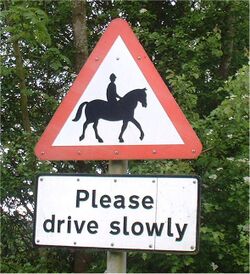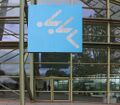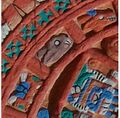Pictogram
 From HandWiki - Reading time: 6 min
From HandWiki - Reading time: 6 min
A pictogram, also called a pictogramme, pictograph, or simply picto,[1] and in computer usage an icon, is a graphic symbol that conveys its meaning through its pictorial resemblance to a physical object. Pictographs are often used in writing and graphic systems in which the characters are to a considerable extent pictorial in appearance. A pictogram may also be used in subjects such as leisure, tourism, and geography.
Pictography is a form of writing[2] which uses representational, pictorial drawings, similarly to cuneiform and, to some extent, hieroglyphic writing, which also uses drawings as phonetic letters or determinative rhymes. Some pictograms, such as Hazards pictograms, are elements of formal languages.
"Pictograph" has a different definition in the field of prehistoric art (which includes recent art by traditional societies), where it means art painted on rock surfaces. This is in comparison to petroglyphs, where the images are carved or incised. Such images may or may not be considered pictograms in the general sense.
Historical
Early written symbols were based on pictographs (pictures which resemble what they signify) and ideograms (symbols which represent ideas). Ancient Sumerian, Egyptian, and Chinese civilizations began to adapt such symbols to represent concepts, developing them into logographic writing systems. Pictographs are still in use as the main medium of written communication in some non-literate cultures in Africa, the Americas, and Oceania[citation needed]. Pictographs are often used as simple, pictorial, representational symbols by most contemporary cultures.

In 2011, UNESCO's World Heritage List added "Petroglyph Complexes of the Mongolian Altai, Mongolia"[4] to celebrate the importance of the pictograms engraved in rocks.
Some scientists in the field of neuropsychiatry and neuropsychology, such as Mario Christian Meyer, are studying the symbolic meaning of indigenous pictograms and petroglyphs,[5] aiming to create new ways of communication between native people and modern scientists to safeguard and valorize their cultural diversity.[6]
Modern uses
An early modern example of the extensive use of pictographs may be seen in the map in the London suburban timetables of the London and North Eastern Railway, 1936–1947, designed by George Dow, in which a variety of pictographs was used to indicate facilities available at or near each station. Pictographs remain in common use today, serving as pictorial, representational signs, instructions, or statistical diagrams. Because of their graphical nature and fairly realistic style, they are widely used to indicate public toilets, or places such as airports and train stations. Because they are a concise way to communicate a concept to people who speak many different languages, pictograms have also been used extensively at the Olympics since 1964 Tokyo Summer Olympics, designed by Masaru Katsumi, and are redesigned for each set of games.[7][8][9]
Pictographic writing as a modernist poetic technique is credited to Ezra Pound, though French surrealists credit the Pacific Northwest American Indians of Alaska who introduced writing, via totem poles, to North America.[10]
Contemporary artist Xu Bing created Book from the Ground, a universal language made up of pictograms collected from around the world. A Book from the Ground chat program has been exhibited in museums and galleries internationally.
Pictograms are used in many areas of modern life for commodity purposes, often as a formal language (see the In mathematics section).
In mathematics
In statistics, pictograms are charts in which icons represent numbers to make it more interesting and easier to understand. A key is often included to indicate what each icon represents. All icons must be of the same size, but a fraction of an icon can be used to show the respective fraction of that amount.[11]
For example, the following table:
| Day | Letters sent |
|---|---|
| Monday | 10 |
| Tuesday | 17 |
| Wednesday | 29 |
| Thursday | 41 |
| Friday | 18 |
can be graphed as follows:
| Day | Letters sent |
|---|---|
| Monday | |
| Tuesday | |
| Wednesday | |
| Thursday | |
| Friday |
As the values are rounded to the nearest 5 letters, the second icon on Tuesday is the left half of the original.
Standardization
Pictographs can often transcend languages in that they can communicate to speakers of a number of tongues and language families equally effectively, even if the languages and cultures are completely different. This is why road signs and similar pictographic material are often applied as global standards expected to be understood by nearly all.
A standard set of pictographs was defined in the international standard ISO 7001: Public Information Symbols. Other common sets of pictographs are the laundry symbols used on clothing tags and the chemical hazard symbols as standardized by the GHS system.
Pictograms have been popularized in use on the web and in software, better known as "icons" displayed on a computer screen in order to help user navigate a computer system or mobile device.
Native American pictographs from the Great Gallery, Horseshoe Canyon, Canyonlands National Park
See also
- Bouba/kiki effect
- Crop art
- Emoticon
- Emoji
- Icon (computing)
- Ideasthesia
- Ideogram
- List of Stone Age art
- List of symbols
- List of writing systems § Pictographic/ideographic writing systems
- Pecked curvilinear nucleated
- Petroform
- Petroglyph
- Rebus
- Road sign
- Rock art
- Rock art of the Chumash people
- Sound symbolism
- Stick figure, in art
- Symbol
- Traffic sign
- Warning sign
- Yakima Indian Painted Rocks
Notes
- ↑ Gove, Philip Babcock. (1993). Webster's Third New International Dictionary of the English Language Unabridged. Merriam-Webster Inc. ISBN:0-87779-201-1.
- ↑ Goody, Jack (1987). The interface between the written and the oral. Cambridge [Cambridgeshire]. pp. 4. ISBN 0-521-33268-0. OCLC 14242868. https://www.worldcat.org/oclc/14242868.
- ↑ "Signatures from the Past". European Southern Observatory. 30 January 2017. https://www.eso.org/public/images/potw1705a/.
- ↑ "Petroglyphic Complexes of the Mongolian Altai". UNESCO World Heritage Centre. 2011. https://whc.unesco.org/en/list/1382.
- ↑ Meyer, Mario Christian (December 1985). Apprentissage de la langue maternelle écrite: étude sur des populations "les moins favorisées" dans une approche interdisciplinaire. ED-85/WS/65. http://unesdoc.UNESCO.org/images/0006/000678/067843F.pdf.
- ↑ Meyer, Mario Christian. "Out Of The Forest & Into The Lab: Amerindian Initiation Into Sacred Science". in Bloom, Pamela. Amazon Up Close. http://www.pisad.bio.br/artigos/amazonupclose_outoftheforest.pdf.
- ↑ Hall, C. Justin; Allen, Zachary. "Olympic Pictograms". Visual Rhetoric. https://pages.uncc.edu/visualrhetoric/projects/illustration-video/olympic-pictograms/.
- ↑ "Olympic Pictograms: Design through History". MediaMadeGreat.com. 16 August 2016. https://mediamadegreat.com/olympic-pictograms/.
- ↑ Popovic, John Jan, ed. "Olympic Games Pictograms". http://1stmuse.com/pictograms/.
- ↑ Reed 2003, p. xix
- ↑ "Understanding pictograms". http://www.bbc.co.uk/skillswise/factsheet/ma37grap-e3-f-pictograms.
References
- Reed, Ishmael (2003). From Totems to Hip-Hop: A Multicultural Anthology of Poetry Across the Americas, 1900–2002, Ishmael Reed, ed. ISBN:1-56025-458-0.
External links
- Pictogram & Communication: About 1,500 practical pictograms based on Design principles of pictorial symbols for communication support(JIS T 0103:2005)
- CAPL:The Culturally Authentic Pictorial Lexicon, photographic illustrations of objects for multiple languages
- Pictogram Encyclopedia, The collection site of more than 500 pictograms, Pictograms are categorized, and easy to find unique pictogram
- Pictopen - Modern Pictographic Writing
- NounProject - Free Pictograms under open licences
- Modern Pictograms - Explore word and pictogram relationships
- Wolfram|Alpha - Number to pictogram translator
- icons - download free icons for commercial and non commercial uses
 |
 KSF
KSF







